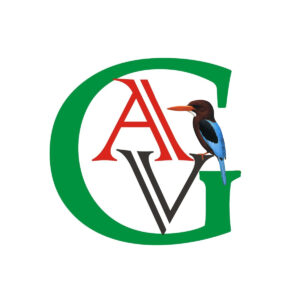Text and images by Irfan Rosyadi/ Yayasan Kanopi Indonesia
The Javan sparrow Lonchura oryzivora is an endemic bird to Java and Bali Island which is threatened to extinction due to the overharvesting and the ongoing hunting activity. According to (Yudha 2008) Java sparrow population is still found in Gunungkidul (part of Gunung Sewu karst landscape) Yogyakarta java island in very small population. The population is spread in some locations in Gupak warak, Jotak Cave, Mandung Cave Tritis and Maria cave, but disappeared from the former habitat, Gelatik Cave and Gelatik island.
Between 2017-2018 Kanopi Indonesia have conducted survey which was supported by Oriental Bird Club shows that from 15 former habitats only five (3 districts, Girisubo, panggang and paliyan) are still occupied by java sparrow with the total population between 83-113 individuals (Rosyadi et al. 2019). The major threat to Java Sparrow in the region continues to be poaching—either using mist-nets or by direct collection of chicks during the breeding season. Some poachers are local villagers, but others come to the area from the neighboring Bantul and Wonogiri regencies. During the survey we found Java Sparrows for sale at the bird markets in Yogyakarta and Prambanan; sellers informed us that some of the birds were originally caught in the Gunungkidul area (Rosyadi et al. 2019).
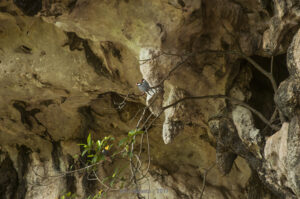
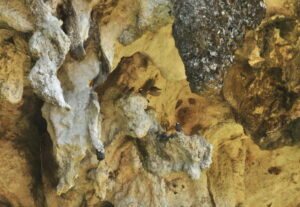
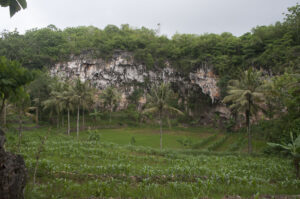
Java sparrow is known to be roosting and nesting colonially. Our survey in 2017-2018, found 3 big colony of java sparrow in Gunungkidul, one colony in Song banyu Girisubo subdistrict, (n: 40-50 ind), two colony in Panggang sub district comprising jothak cave (n: 12-20 ind) and song gobar cliff (50-60 ind). In 2019-2020 we are focused on monitoring the java sparrow colony in Panggang district which covers two nesting sites in jothak cave and song gobar cliff. However, based on monitoring we found java sparrows disappearing from the roosts or nest sites we have identified. The colony in Song gobar has disappeared or has shifted to another unknown place. On the other hand we found a java sparrow colony (n:87 ind) while foraging in a farm field area in Tedunan area about 5 km away from Song Gobar cliff. We didn’t know whether they are the same colony as well as where they were roost.
The current Java sparrow roost site in Panggang is difficult to spot because of their uncertain movement pattern. It is presumably related to the food resources availability, as grass or wheat will be difficult to find in this area during the dry season. But the other reason is due to the poaching which usually looks for a nest in the clift for its java sparrow chicks. The other disturbance also comes from squirrel hunting using air guns. They hunt squirrels as often seems at cliffs where java sparrows roost or nest.. We need to encourage the local community to protect java sparrow habitat to make it live sustainably. 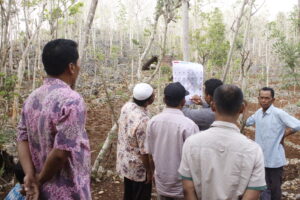
During November 2019 to August 2020 we have initiated java sparrow monitoring involving the local community, especially farmers (most of them Women) as participants. This monitoring covers two villages in Panggang sub district including Giriwungu village and Girikarto village. To monitor java sparrows, we use calendars which have been modified like monitoring sheets, and distribute it to the participants. They can record the encounter with a java sparrow, they don’t need to spend a particular time observing but they can do it any time by adjusting their daily activity, such as when they go to a farm field or to the cowshed . So they can simply tick the date box, and fill that box with location, and the number of individuals.
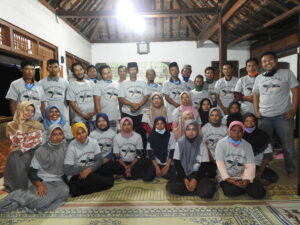
We have involved 34 farmers and we have managed to collect 14 encounter reports, but only nine were verified while 5 of them were incomplete as there was a lack of place and number of individual information. After project implementation they have willingness to continue the monitoring but they still need assistance from Kanopi Indonesia as they don’t have capacity yet to manage this monitoring independently.
Conserving java sparrows involving the local farmer in the project site is very challanging especially since java sparrows still have negative stigma as a rice farming pest, we need a strategy to mitigate the conflict. It is important to develop an integrated strategy which includes compensation together with other tools, such as land-use planning, direct incentives, preventative management measures and raising community awareness. It is important to develop conservation that will benefit local economies such as, bird adoption scheme. The bird adoption will enable the wider community to give donations for the local community group to monitor birds and also guard birds from hunting. For the farmer whose land used to be visited by java sparrow it deserves an operational cost for their monitoring participation.
PROJECT AREA
Our project site, Gunung Sewu UNESCO Global Geopark is a classic tropical karst landscape in the south-central part of Java Island well-known in the world and dominated by the limestone. The limestone has been formed since the Neogene age and consists of calcareous-tuffaceous clastic facies as well as reef facies.
Gunung Sewu UNESCO Global Geopark is stretching across several regencies (Gunungkidul, Wonogiri, Pacitan) and provinces (Yogyakarta, Central Java, East Java). It is inhabited by approximately 805,000 inhabitants. Local economy is derived from agriculture and services sectors. Protection and preservation of the Earth’s heritage become a shared responsibility between the Regency Government and Travel Awareness Group who manage the sites and develop them into objects of interest and tourist attractions. At national level, the diversity of karst landscapes, rocks, fossils as well as geological processes are protected by Government Regulation since 2008 in the form of Geological Reserve Area (GRA). In addition to its aesthetic and recreational values, Gunung Sewu is rich in biodiversity, archeology, history and cultural aspects. Pacitanian stone-culture represents Paleolithic to Neolithic artifacts in Southeast Asia.
Gunungkidul regency area is located between 7.96668°S and 110.602561°E Longitude. It covers an area of 1,485.36 km2 and had a population of 675,382 at the 2010 Census and 747,161 at the 2020 Census. Gunungkidul Regency is in a karst region. This leads to difficult geography for farmers and contributes to considerable poverty in the area because of water shortages. The area of Gunungkidul Regency is 1.485,36 sq. Km which consists of 18 districts and 144 villages/wards (BPSK 2015).
Gunungkidul has 54.670 ha forest consisting of State-owned Forest and small holder forest area however no more natural forest remains. Vegetation is dominated by plantation mostly by teak tree (Tectona grandis), and the other important tree comprising Mahoni (Swietenia mahagoni), Akasia (Acacia auriculiformis), sonokeling (Dalbergia latifolia), Randu (Ceiba pentandra), Pule (Alstonia scholaris) and scrub of chromolaena odorata and Lantana camara. Thesome key bird species in this area comprising the threatened bird species, Ruby-throated bulbul (Pycnonotus dispar), Javan coucal (Centropus nigrorufus).
Number of rain days and rainfall is 198,78 mm per year, this area is considered to be a dry area which is caused by rapid and substantial infiltration of water into the soil and rock (Whitten et al. 1996). Water necessities are dominantly supplied from rainwater. However, farming is the primer livelihood form most of the people in the project site. Farmer will grows plans in rainy season October-April, with cassava, corn, peanut, eggplant and “gogo Rice” (a rice variety who adaptive to grow in dry land) while in May-September will only remaining Cassava which will be harvested in July or august, the will start planting waiting for the rainy season.
They are usually also raising cows at their farm field which is placed on a little cowshed. During the dry season they will face difficulty to find grass and water, they will buy grass (rice straw and corn stem) from the neighboring regency like from Bantul and Sleman regency. Java sparrows usually visit the cowshed for foraging rice which still remains among the straw.
OBJECTIVEs
- Strengthening locals community participation in java sparrow monitoring to support bird adoption programs .
- Initiating conservation models which benefit the community through bird adoption.
- Encouraging local regulation to support java sparrow conservation in panggang district Gunungkidul regency, Gunung Sewu Geopark
The project is kindly sponsored by Silent Forest partners Wilhelma Zoo, Basel Zoo and the Gesellschaft für Arterhaltende Vogelzucht e.V
Literature 2019 Rosyadi et all. Conservation of Java Sparrow Gn Sewu Geopark
Updates
The project was initiated March 2023 and runs for two years
Project visit 25-06-2024 Java Sparrow update



